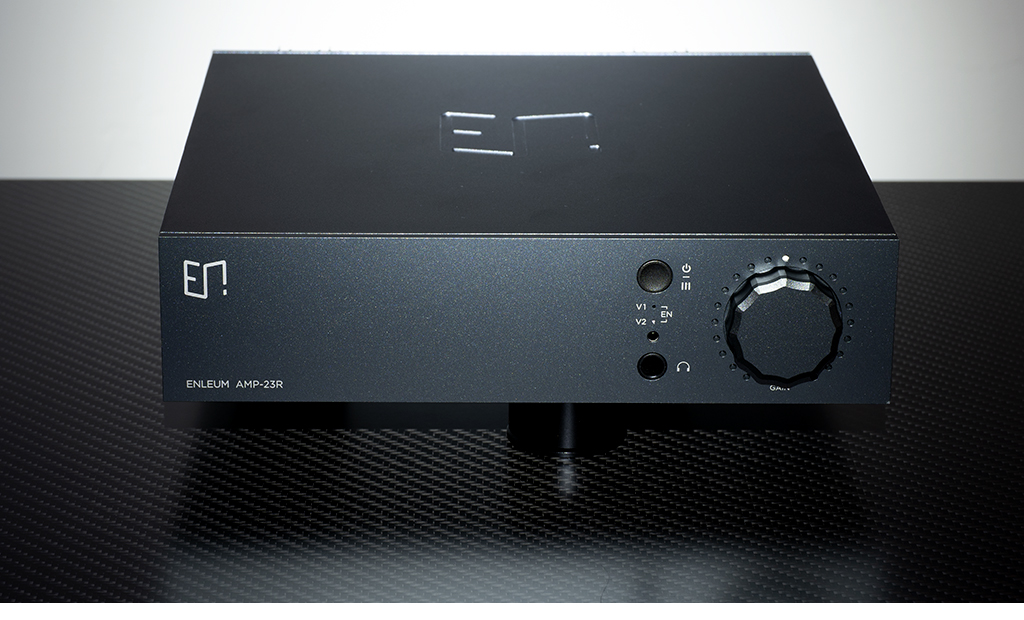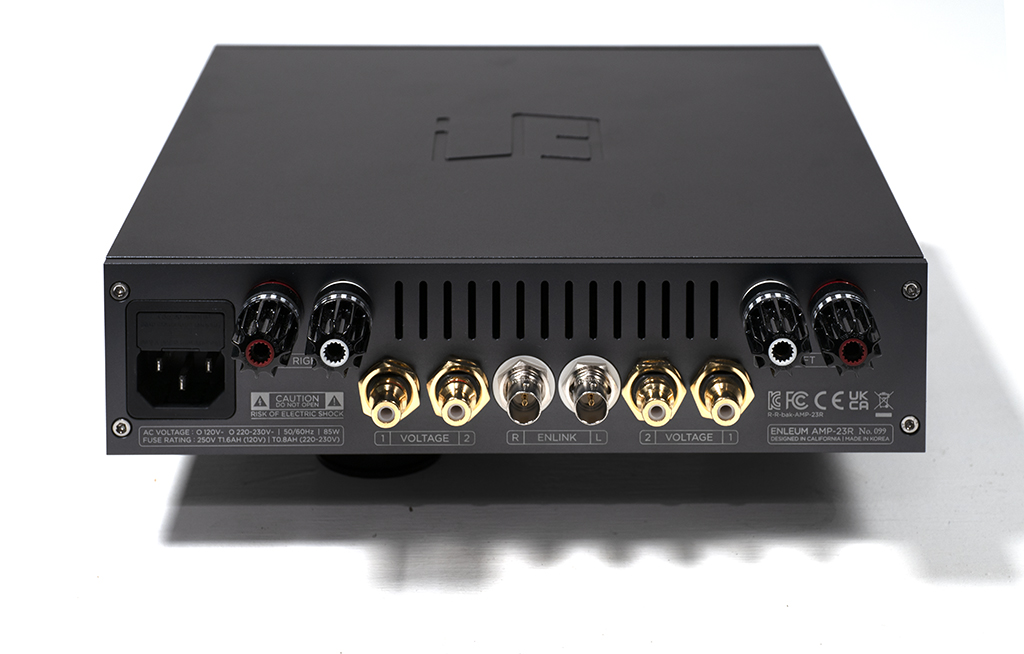
If you happen to be an audio enthusiast that is only impressed with large racks of gear, and convinced this is the only way to go, skip this review. You won’t want the Enleum AMP-23R. It’s small. Tiny, actually. Like 9 inches square and a little over 3 inches tall with super cool feet attached. I’ve seen bigger apple pies than this.
In all seriousness, it has about the same footprint as a Nagra Classic component and is half the height. Listening to the Chemical Brothers “Live Again,” the amount of bass at my command is staggering, controlled, and well defined – as listening to the Chemical Brothers should be. The rest of the frequency spectrum is equally well rendered.
For the rest of you, this amplifier is so special, there’s no real cliché to describe it. Often, as you go up the range of the world’s finest components, they reveal more music – more resolution, less noise, more dynamics, more of their core voice. What if you could have a modest helping (i.e. 25 watts worth) of “as good as it gets” sound for $6,250? That’s the Enleum AMP-23R. After a lot of listening comparisons, it stacks up with the finest gear.
At first, the thought of adding another great, low-powered amplifier to work with some of the high sensitivity speakers we’ve been reviewing, and keeping the hours low on my 300Bs was appealing. However, the minute the AMP-23R was connected up to the Peak Consult Sinfonias ($55k/pair) in place of the C-J ART88/PS Audio BHK600 monos powering them for some initial run in, the AMP-23R is non stop excitement. Running through track after track of music that’s been our review staples for 20 years, the AMP-23R turns in an incredible performance.
So intrigued with this, moving the AMP-23R over to the YG Hailey 3s ($67,000/pair) with a similar sensitivity, but different tonality than the Peaks, and even slightly more resolving, this little amplifier delivers an equally engaging performance. In both instances the source component is the dCS Vivaldi ONE. This is the point in the review, where excuses are made that the review component, only a fraction of the cost of the mega gear in said reference system really doesn’t measure up. Nope. Not here. Of course, the Enleum amplifier will not drive the Peaks or the Haileys to the same level as the big Pass or big PS monoblocks.
The sheer quality of musical experience delivered by the AMP-23R at reasonable volume levels is as good as it gets. (with modest efficiency speakers.)
The only reason I mention the cost of the first two speakers used with the AMP-23R is to illustrate the level of resolution it is capable of – and that it does not sound out of context in a 200k system. Hiding it in the rack when a few friends visited made it a lot of fun to play tricks with them. No one could believe this small amplifier could deliver such an exciting performance!
A fantastic partner for high sensitivity speakers
Installing a pair of efficient speakers is an even more amazing experience. If you’ve always liked horns, or other high sensitivity speakers, but still hold a bit of trepidation about SET amplifiers, the AMP-23R will surprise you in a very good way.
The relatively high impedance of most SET amplifiers makes them slightly more speaker sensitive than other amplifiers, and it’s usually the bass response that takes a hit, combined with their low damping factor, there aren’t many SETs with true bass grip. (Though we have had excellent results with Nagra, ampsandsound, and WAVAC, but these are all much more expensive than the Enleum)
Swapping speakers for the Heretic AD612s (98dB/1-watt), and the new Zu Audio DWXs (95dB/1-watt) both make the AMP-23Rs 25 watts per channel into 8 ohms (45 watts into 4 ohms) seem like way more power than you’d ever need. Even with the higher impedance Zu and Heretics, the AMP-23R never runs out of power.
More listening
Every bit of music selected was a wonderful experience through the AMP-23R. No matter what you enjoy, I think you will be fulfilled. The amplifier possesses a prodigious level of pace and timing. When listening to the usual Blue Note favorites, every player is locked down and does not waver. Tracking through Herbie Hancock’s Main Title theme to Blow Up, the drums are planted at the rear of the soundstage, as Freddie Hubbard’s horn comes in over Hancock’s piano.
Female vocal lovers just might think they are listening to an SET, because of the sheer delicacy this amplifier portrays the human voice. Whether I was listening to Chrissie Hynde, Christine Mc Vie, or Christina Aguilera, every subtle nuance of their voices came through with spectacular feel.
Transient response is also excellent, with no sense of fog, cloudiness, or overhang. Drum heavy music (take your pick) is refreshingly open and punchy. This contributes heavily to a complete lack of fatigue when listening for hours on end. Finally, the sound field created is immense in all three directions, yet the AMP-23R allows music to scale up and down with ease, and it sounds fantastic at very low volume levels as well. Zero complaints here.
A few comparisons
With a couple of great single ended and low powered tube amplifiers on hand to drive the Zu and Heretic speakers, it made sense to undertake some A/B comparisons. To be fair, the $24k pair of ampsandsound Bryce monoblocks deliver slightly more midrange magic and a bit larger overall soundstage. The Pass First Watt SIT-3 offers a bit more organic, warmer presentation, and the Pass INT-25 even warmer still. The Coincident Frankenstein amplifier with WE 300Bs also gives a bit more bloom, but it is in a fun, saturated way.
Except for the Pass INT-25, all of these are more expensive, power amplifiers only, and delivered the performance they did with the $38,000 Pass XS Preamplifier driving them. And tubes are tubes. Sometimes more glorious, but always needing replacement. The Pass INT-25 is more expensive, much larger, and much heavier, with a different tonality.
The point here is not to show any disrespect for the other players, but to again underline just how good the AMP-23R is.
The Enleum difference
There have been a handful of great phono preamplifiers that operate in current mode, providing a tremendously transparent view of the music. The AMP-23R works this way as well, and the volume control varies the amplifier’s gain, instead of merely attenuating the input. Peaking inside, reveals a pair of Ensense gain modules and a single pair of output transistors bolted to the chassis as a heat sink. Please note, the Ensense modules use all discrete transistors, and no negative feedback. Taking the circuit further, Enleum’s JET2 Bias circuit works in real time to constantly monitor (and correct as needed) each pair of EXICON MOSFETS that make up the output stage.
The stark, yet highly fashionable casework takes the same approach as the circuit design. Ergonomics are top notch, and the machining quality is both tasteful and superb. Even the carefully designed trio of vibration controlling feet work with the mechanical design to keep a minimum of mechanical noise from entering the circuit board.

Around back is a pair of analog RCA inputs marked “Voltage.” These are traditional analog inputs, and the pair of BNC inputs in between them are marked “Enlink,” which are reserved for future Enleum products to work in current mode. (hopefully, a phono stage and matching DAC?) Finally, a small but efficient remote takes care of controlling things from your listening position.
A winning combination
The AMP-23R does everything right. No make that perfectly. In the couple of months that it’s been here, it’s literally a freak out every time we use it. And it’s been so much fun to have audiophile buddies visit with the AMP-23R playing on top of a rack full of massive gear and walk up to turn the level up on this tiny box. Surprise all around, and that’s a great thing.
I’d suggest a 90db/1-watt pair of speakers if you really need serious volume levels, but with the level of musical information that the Enleum 23R reveals, there isn’t a set of speakers under $100k a pair I wouldn’t connect it to. And it’s a killer headphone amplifier too. A quick email to Enleum reveals that the headphone jack is connected directly to the output stage, so it takes full advantage of the circuit, unlike so many integrated amplifiers that tack on a simple op-amp circuit as an afterthought.
Using the Focal Utopia 2022s for reference listening again shows off just how musical and resolving the AMP-23R is. Theoretically, you could buy this amplifier for headphone use only and still feel like you got a good deal.
Conclusion
They say that a true master knows where to pound the nail. I submit the founder of Enleum, Soo In Chae, is in the league of the true masters. The final measure of a top-quality product is the way every aspect of said product is realized. In addition to class A+ sound, this amplifier is wonderfully crafted, and finished to perfection. It is as much a joy to physically interact with and use as it is to listen to.
This amplifier more than deserves to sit on the same shelf with the world’s finest gear. I’ve purchased the review sample, and it will be doing just that here for years to come. I anxiously await what Enleum will bring to market next.
https://enleum.com/amp-23r/

















